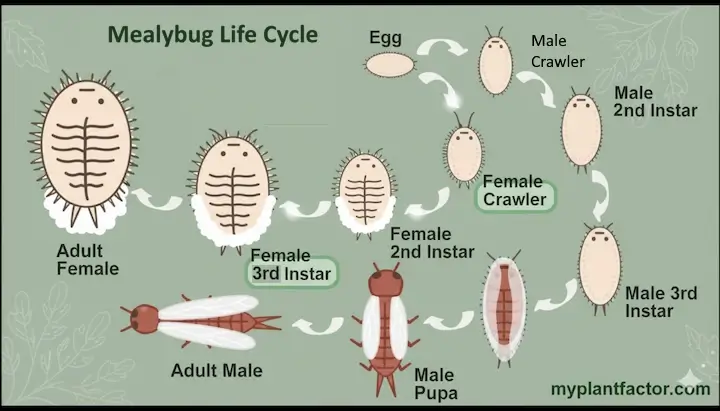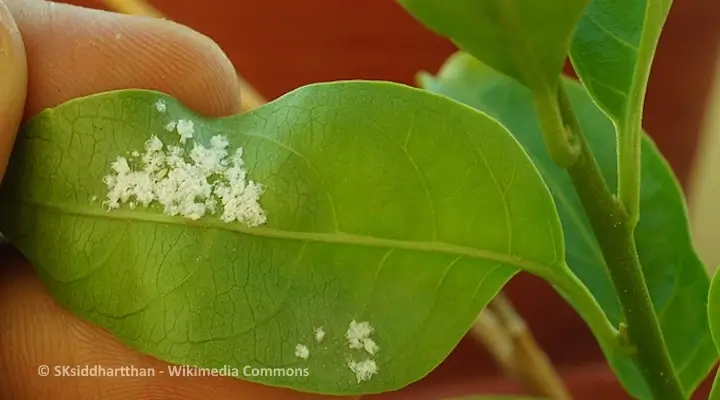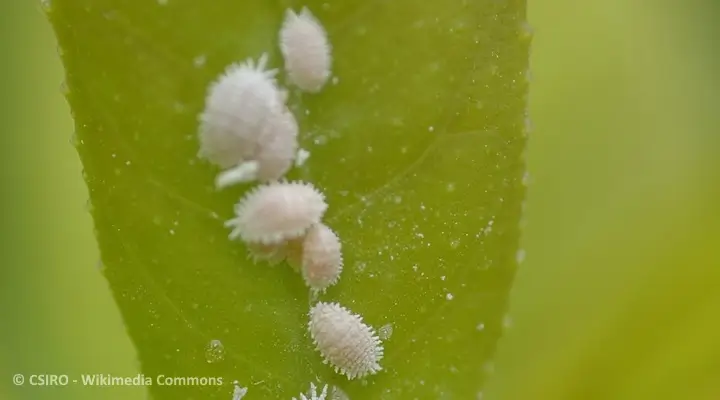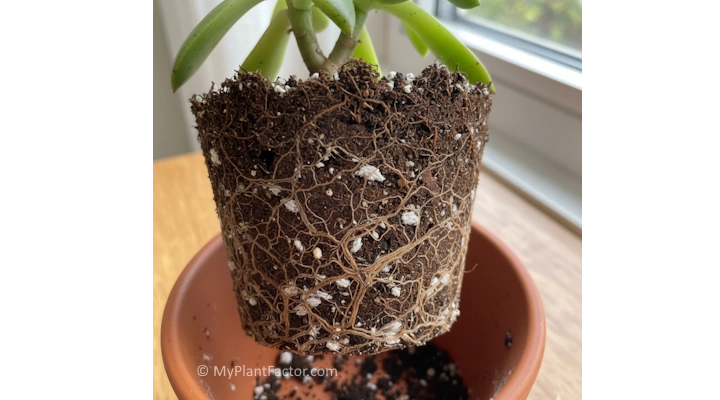
Mealybugs on Houseplants: Life Cycle, Hidden Habits, and How to Break Them

Mealybugs on houseplants are sneaky—tiny white specks that look like cotton fluff until they start to move. One day, your philodendron looks fine, the next it’s sticky with honeydew, drooping, and crawling with these pale-colored sap-sucking freeloaders.
Table of Contents
Ask around in any houseplant subreddit and you’ll hear the same regret: “I thought it was just dust… until it spread.” It happens fast. These pests hide in leaf joints, soil crevices, even under pots, quietly multiplying while you water them like nothing’s wrong.
I’ve fought them more times than I’d like to count, and trust me—they don’t go down without strategy. But once you understand their life cycle and where they hide, you can actually break the cycle for good.
Stick around—this guide shows exactly how to spot, treat, and prevent mealybugs before your next infestation ever begins.
What Are Mealybugs?
If you’ve ever seen tiny white specks that look like lint clinging to stems, that’s your first clue: mealybugs have set up home in your beloved houseplants. They’re soft-bodied, sap-feeding insects that pierce your plant’s tissue and drink its juices until the leaves wilt and shine with sticky residue.
Most belong to species like Planococcus citri—the citrus mealybug—or Pseudococcus longispinus, the longtailed mealybug. Indoors, these are the ones haunting your jade plant, philodendron, or pothos. A close cousin, Rhizoecus falcifer, is the root mealybug—an underground version that attacks plant roots.
They’re covered in a powdery wax, almost like they’ve been dusted with flour. Some form waxy tufts or cottony egg sacs, hiding nymph stages under leaf joints and pot rims. Each female lays dozens of eggs in a fluffy cocoon of white waxy material—those “cotton clumps” you see on stems.
Their damage shows fast: yellowing leaves, stunted growth, and black sooty mold from honeydew buildup. And once that mold appears, you’re already feeding more pests than you realize.
The Mealybug Life Cycle
Understanding the mealybug life cycle is the real trick to breaking it. These sap-feeding insects move through several sneaky stages, and each one requires a different response.

Here’s how it plays out:
- Eggs: Females lay up to 600 eggs inside fluffy white sacs made of waxy threads. These egg masses stick to stems, leaves, or the undersides of pots.
- Crawlers (nymphs): The newly hatched nymph stages are mobile and spread fast. They’re tiny—barely visible—and often mistaken for dust.
- Juveniles: After settling, they insert their mouthparts into plant tissue and start feeding. They secrete a protective layer of powdery wax.
- Adults: Females remain wingless, covered in white waxy material; males develop small wings but don’t feed.
- Egg to adult: Indoors, the full life cycle takes about six weeks, and it never stops because mealybugs don’t face freezing temperatures.
Most infestations start with Planococcus citri (citrus mealybug) or Pseudococcus longispinus (longtailed mealybug), though root mealybugs (Rhizoecus falcifer) stay hidden in the soil and attack plant roots.
Experts at Wisconsin Horticulture note that heavy populations often cause black sooty mold to form on leaves due to honeydew buildup, making photosynthesis even harder for your plant.
That’s why control needs to hit every stage—from egg sacs to nymphs to adults—or they’ll rebound stronger.
Where Mealybugs Hide and Why You Don’t Notice Them Until It’s Too Late
Mealybugs are pros at hide-and-seek. They wedge themselves in every tight corner of your indoor plants, protected by that stubborn layer of powdery wax that repels sprays and traps moisture.

Here’s where they love to hide most:
- Leaf joints and nodes: The perfect spot for egg sacs and waxy tufts—especially in dense foliage like pothos or jade plants.
- Stem crevices and under leaves: Females lay eggs in these tucked-away folds, safe from your cotton swab or qtip method.
- Pot rims and drainage holes: Crawlers sneak under the lip of the pot or gather where the soil meets the container.
- Root ball: Root mealybugs (Rhizoecus falcifer) cluster around plant roots, feeding unseen until you lift the pot and spot white waxy material in the soil.
- Cacti and succulents: These pests love the dry joints where air barely circulates.
Indoors, where humidity and steady warmth mimic greenhouse conditions, infestations spread fast. You’ll notice sticky honeydew on leaves long before you see the insects. That’s usually followed by black sooty mold—a sure sign the colony’s thriving.
I once found a whole population hiding inside a terracotta pot seam. By the time I spotted the waxy threads, the soil smelled sweet, and my plant’s roots were gone.
They’re quiet destroyers—but knowing where to look gives you the upper hand.
Early Signs Your Houseplants Have Mealybugs
The first indications of mealybugs on houseplants include white, cottony wax, sticky honeydew, and the black sooty mold that follows. Plant experts at the University of California describe these pests as soft, wax-covered insects that hide in sheltered spots, feeding on sap and weakening plant health.

They call it “common on houseplants in mild indoor climates,” which—let’s be real—means your living room.
Here’s what to look for:
- Fluffy white wax or cotton-like tufts on stems or leaf joints.
- Sticky honeydew on leaves that soon turns into black sooty moulds.
- A dull, sticky film coating pots or tabletops below the plant.
- Wilting or slow, stunted growth, even though watering is on point.
- Root mealybugs (Rhizoecus species) leave white residue around plant roots or the pot rim.
- Clusters around tender shoots, hoya leaves, or orchid nodes—especially in warm, humid corners.
- In severe infestations, leaves may yellow or drop prematurely.
Plant parents on Reddit say the same. One wrote, “I thought it was perlite until it moved,” while another said, “The leaves looked shiny, then the ants showed up.” However, another person shared, “I only realized something was wrong when the leaves developed a dusty black coating.
Those subtle changes—white wax, sticky film, dull leaves—are your plant whispering, help me. Catch it here, and you can stop the infestation before it spreads pot to pot.
Natural Mealybug Control and Treatment Methods
Every plant parent hits this stage eventually—staring at a sticky philodendron and muttering, “Now what?” Don’t panic. You can treat mealybugs naturally without reaching for harsh chemicals.

Rubbing alcohol: Use the q-tip method—dab each insect with 70 % isopropyl alcohol. It dissolves the wax instantly, something most soaps can’t do. Test on one leaf first; delicate plants may scorch.
Insecticidal soap: Choose a mild formula labeled for indoor plants. It breaks through the mealybug’s powdery wax so the spray actually reaches the soft body beneath.
DIY Neem Oil spray: Cold-pressed neem is your quiet hero here. It suffocates active bugs while disrupting egg development over several life cycles. If you’re new to neem, read my detailed guide on using Neem Oil for houseplants before you mix your first batch—it’s the safest way to treat pests organically.
Horticultural oil: For stubborn clusters, light horticultural oils such as Conqueror Oil or silica-based additives like Dyna-Gro ProTekt coat remaining colonies and block oxygen exchange.
Water spray: A firm rinse every few days clears honeydew and dislodges crawlers. It’s low-tech but perfect for tough leaves and stems.
Chemical pesticides rarely help; their residue can’t pierce the waxy layer and may kill beneficial predators like Cryptolaemus montrouzieri, the mealybug destroyer beetle.
Treat weekly until no new tufts appear and leaves lose their sticky feel. Then shift to maintenance—regular inspection and light neem misting keep future outbreaks away.
For broader pest control tips that cover all types of white bugs, read White Bugs on Houseplants: Spot, Treat, and Stop the Infestation.
Root Mealybugs: The Hidden Reasons Houseplants are Suffering
If your plant looks fine above the soil but keeps wilting no matter what you do, you might be dealing with root mealybugs—the sneakiest branch of the family.

They live deep in the root ball, clustering around fine roots and pot edges. UC IPM notes that ground-dwelling species like Rhizoecus falcifer feed just like their leaf-loving cousins—sucking sap, excreting honeydew, and coating roots in white waxy material. You’ll spot them when you unpot the plant and see cotton-like residue clinging to roots or the base of the stem.
Symptoms below the soil line
- Persistent drooping or yellowing despite good watering habits.
- White powder coating the soil line or drainage holes.
- A sweet or musty smell from damp soil—early honeydew buildup.
- Fine roots darkened or brittle from feeding damage.
How to flush and treat roots without killing the plant
To treat them, you’ll need to go below the surface:
- Unpot the plant and gently shake or rinse away as much old soil as possible.
- Flush the roots with a mix of lukewarm water and a little hydrogen peroxide (about one part 3% peroxide to four parts water). It oxygenates the soil, kills lingering eggs, and helps prevent fungal growth while loosening any stubborn wax from root mealybugs.
- Inspect the root ball—if you still see waxy threads, use a soft brush or cotton swab dipped in alcohol to remove them.
- Repot into fresh, sterile mix, and wash the container with hot soapy water before reuse.
Avoid chemical pesticides; they rarely penetrate the soil deep enough to reach colonies. If infestations return, you can consider a mild systemic like Captain Jack’s Systemic Houseplant Insect Control—but always as a last resort and in strict moderation.
Biological control also works if you’re patient: beneficial insects such as Cryptolaemus montrouzieri or certain parasitic wasps feed on subterranean mealybug eggs and crawlers.
The secret to keeping mealybugs away isn’t luck—it’s rhythm. Little habits that stack up until pests just stop showing up.
Mealybug on Houseplants: Prevention and Long-Term Control
To prevent mealybugs on houseplants, isolate new plants before introducing them, keep leaves clean with a light Neem Oil mist, and avoid overwatering or excess fertilizer. Good airflow, balanced light, and routine leaf checks stop infestations before they start—keeping your indoor plants healthy, resilient, and mealybug-free.
Here are my top prevention tips:
- Quarantine new arrivals: Keep new plants apart for a couple of weeks, and peek under the leaves every few days. It’s like a customs check for bugs.
- Maintain airflow and light balance: Mealybugs thrive in still, dim corners. Rotate your plants, crack a window, or run a fan occasionally. Bright, moving air keeps foliage firm and far less tempting to sap-feeding insects.
- Regular leaf cleaning: Once a month, wipe down leaves with a damp cloth and check for signs of mealybugs. A light neem oil spray also acts as a deterent.
- Smart watering and fertilizer habits: Wet soil and constant feeding invite trouble with mealybugs and fungus gnats. Water only when the top inch feels dry, and skip that “just one more dose” of fertilizer.
The trick isn’t perfection—it’s awareness. A quick glance under the leaves, a steady hand with the watering can, and your plants will stay clear, glossy, and mealybug-free.
Common Mistakes to Avoid
Common mistakes when treating mealybugs on houseplants include stopping treatment too early, skipping root checks, and overwatering after infestations. Mealybugs often reappear because eggs hatch weeks later. Keep treatments consistent, inspect the soil line, and clean tools between uses to prevent pests from returning.
Mealybugs on Indoor Plants: FAQs
How long does it take to get rid of mealybugs?
Typically 3–6 weeks. Mealybugs hatch in waves, so repeat treatments weekly until you see no new white tufts for two full weeks.
Can mealybugs live in soil?
Yes—root mealybugs hide in the root ball and near drainage holes. Unpot, rinse roots, flush with diluted hydrogen peroxide, and repot in fresh mix.
Can I reuse soil after a mealybug infestation?
Best not. Eggs and crawlers can linger. Discard or compost the old mix and wash pots with hot soapy water or a light peroxide rinse.
Are mealybugs harmful to humans or pets?
No. They’re not toxic. The honeydew is just sticky. Still, prevent pets from chewing infested plants, as some species are themselves mildly toxic.
Why do mealybugs keep coming back?
Treatments often stop too soon. Eggs hidden in leaf joints or roots hatch later. Continue light Neem Oil or soap treatments for several life cycles.
Can I use systemic insecticides on indoor plants?
Only as a last resort. Products labeled for houseplants can reach root mealybugs, but natural methods are preferred in living spaces.
Do mealybugs spread to other plants?
Yes. Crawlers move across shelves and pot rims fast. Quarantine affected plants, clean nearby surfaces with diluted alcohol, and monitor weekly.
What eats mealybugs naturally?
Predators like Cryptolaemus montrouzieri and parasitic wasps. They’re most effective in greenhouses or stable plant rooms with consistent humidity.
